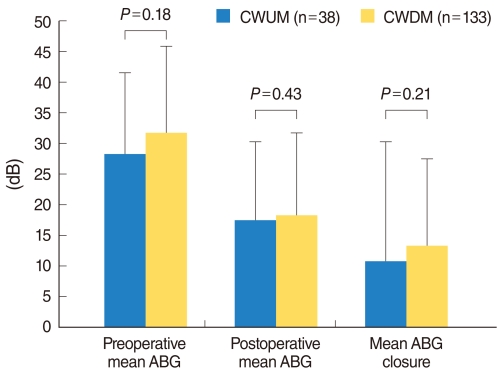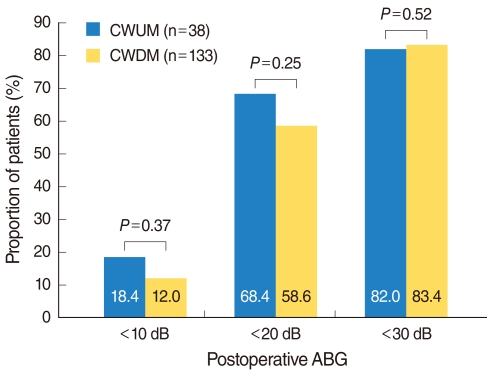Clin Exp Otorhinolaryngol.
2010 Dec;3(4):203-206. 10.3342/ceo.2010.3.4.203.
Hearing Outcomes According to the Types of Mastoidectomy: A Comparison between Canal Wall Up and Canal Wall Down Mastoidectomy
- Affiliations
-
- 1Department of Otorhinolaryngology-Head and Neck Surgery, Samsung Medical Center, Sungkyunkwan University School of Medicine, Seoul, Korea. whchung@skku.edu
- KMID: 2049052
- DOI: http://doi.org/10.3342/ceo.2010.3.4.203
Abstract
OBJECTIVES
The aim of this study was to compare the hearing outcomes between canal wall up mastoidectmy (CWUM) and canal wall down mastoidectmy (CWDM).
METHODS
One hundred seventy one chronic suppurative otitis media (CSOM) patients were enrolled in this retrospective study. The patients who underwent the second staged ossiculoplasty at least 6 months after mastoidectomy and who had an intact, well aerated tympanic cavity as well as intact mobile stapes at the time of operation were selected from the medical record. Based on the type of mastoid surgery, the patients were categorized into two groups: the CWUM (n=38) and CWDM groups (n=133). The hearing results of the CWUM and CWDM groups were compared using the pre- and post-operative air-bone gap (ABG) at 3 months after ossiculoplasty.
RESULTS
The preoperative ABG in both groups (CWUM and CWDM) were 28.4+/-15.6 dB and 31.8+/-14.5 dB, respectively (P=0.18). Both groups didn't show any significant difference (10.9 dB vs. 13.5 dB, respectively) (P=0.21) for the postoperative ABG closure. The proportion of patients with an ABG less than 20 dB was 58.6% of the CWDM patients and 68.4% of the CWUM patients (P=0.25).
CONCLUSION
The type of mastoid surgery (CWUM and CWDM) did not affect the hearing results of CSOM patients. When choosing the type of mastoidectomy procedure for CSOM surgery, the hearing outcomes are basically the same for both types of procedure.
Keyword
MeSH Terms
Figure
Cited by 2 articles
-
Management of Attic Cholesteatoma While Preserving Intact Ossicular Chain; “Modified Bondy Technique” vs. “Canal Wall Up Mastoidectomy with Tympanoplasty Type I & Scutumplasty”
Dan Bi Shin, Jung On Lee, Tae-Uk Cheon, Jung Gwon Nam, Tae-Hoon Lee, Joong Keun Kwon
Korean J Otorhinolaryngol-Head Neck Surg. 2017;60(10):491-496. doi: 10.3342/kjorl-hns.2017.00087.Obliteration of Radical Cavities and Total Reconstruction Procedure Without Staging After Canal Wall Down Mastoidectomy: Long-term Results
Shao-Cheng Liu, Chih-Hung Wang, Bor-Rong Huang
Clin Exp Otorhinolaryngol. 2015;8(3):230-236. doi: 10.3342/ceo.2015.8.3.230.
Reference
-
1. Whittemore KR Jr, Merchant SN, Rosowski JJ. Acoustic mechanisms: canal wall-up versus canal wall-down mastoidectomy. Otolaryngol Head Neck Surg. 1998; 6. 118(6):751–761. PMID: 9627232.2. McElveen JT, Goode RL, Miller C, Falk SA. Effect of mastoid cavity modification on middle ear sound transmission. Ann Otol Rhinol Laryngol. 1982; Sep–Oct. 91(5 Pt 1):526–532. PMID: 7137788.
Article3. Tos M, Lau T. Hearing after surgery for cholesteatoma using various techniques. Auris Nasus Larynx. 1989; 16(2):61–73. PMID: 2803117.
Article4. Cook JA, Krishnan S, Fagan PA. Hearing results following modified radical versus canal-up mastoidectomy. Ann Otol Rhinol Laryngol. 1996; 5. 105(5):379–383. PMID: 8651632.
Article5. Dornhoffer JL, Gardner E. Prognostic factors in ossiculoplasty: a statistical staging system. Otol Neurotol. 2001; 5. 22(3):299–304. PMID: 11347630.
Article6. Becvarovski Z, Kartush JM. Smoking and tympanoplasty: implications for prognosis and the Middle Ear Risk Index (MERI). Laryngoscope. 2001; 10. 111(10):1806–1811. PMID: 11801949.
Article7. Kartush JM. Ossicular chain reconstruction: capitulum to malleus. Otolaryngol Clin North Am. 1994; 8. 27(4):689–715. PMID: 7984370.8. Gyo K, Goode RL, Miller C. Effect of middle ear modification on umbo vibration. Human temporal bone experiments with a new vibration measuring system. Arch Otolaryngol Head Neck Surg. 1986; 12. 112(12):1262–1268. PMID: 3768150.
Article9. Black B. Ossiculoplasty prognosis: the spite method of assessment. Am J Otol. 1992; 11. 13(6):544–551. PMID: 1449182.10. Austin DF. Reporting results in tympanoplasty. Am J Otol. 1985; 1. 6(1):85–88. PMID: 3976866.11. Moon IS, Song MH, Kim HN, Chung MH, Lee WS, Lee HK. Hearing results after ossiculoplasty using Polycel prosthesis. Acta Otolaryngol. 2007; 1. 127(1):20–24. PMID: 17364324.12. Mundada PS, Jaiswal SJ. A method for ossicular reconstruction with tragal cartilage autografts. Laryngoscope. 1989; 9. 99(9):955–962. PMID: 2770385.
Article13. Shelton C, Sheehy JL. Tympanoplasty: review of 400 staged cases. Laryngoscope. 1990; 7. 100(7):679–681. PMID: 2362526.
- Full Text Links
- Actions
-
Cited
- CITED
-
- Close
- Share
- Similar articles
-
- Modified Canal Wall Down Mastoidectomy Without Meatoplasty
- Mastoid Obliteration with Bone Paste and Fat
- Outcomes of Modified Canal Wall Down Mastoidectomy and Mastoid Obliteration Using Autologous Materials
- Reconstruction of the Posterior Canal Wall with Mastoid Obliteration after Canal Wall Down Mastoidectomy
- A Case of Repair of Retroauricular Skin Defect and Mastoid Cavity with Posterior Wall Reconstruction Using Tutoplast(R)(Allograft Cancellous Bone Chip) and Bone Dust after Canal Wall Down Mastoidectomy



